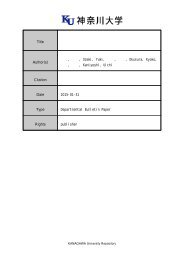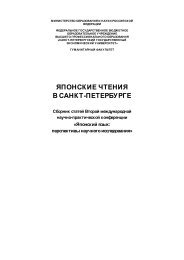to Learners with Special Educational Needs
e-textbook SEN
e-textbook SEN
You also want an ePaper? Increase the reach of your titles
YUMPU automatically turns print PDFs into web optimized ePapers that Google loves.
Pokrivčáková, S. et al. (2015). Teaching Foreign Languages <strong>to</strong> <strong>Learners</strong> <strong>with</strong> <strong>Special</strong> <strong>Educational</strong> <strong>Needs</strong>:<br />
e-textbook for foreign language teachers. Nitra: Constantine the Philosopher University. 128 p.<br />
ISBN 978-80-558-0941-0<br />
The principal requirement is <strong>to</strong> appoint procedures, <strong>to</strong> select <strong>to</strong>pics, vocabulary, teaching<br />
and learning materials, techniques and practices which will be convenient <strong>to</strong> a concrete<br />
group of pupils. All the mentioned items are interconnected and/but are discussed gradually.<br />
The content – new <strong>to</strong>pics, vocabulary, related activities etc., must be presented in small<br />
amounts and a lot of repetition is needed for satisfying learning results. The cognitive functions<br />
(will be mentioned below) have <strong>to</strong> be developed in frames of individual possibilities by using<br />
adequate support from psychological and educational resources and according <strong>to</strong> creative and<br />
inventing effort of the teacher – his/her professional and personal capabilities and<br />
erudition are inevitable.<br />
To set an appropriate procedure in teaching means <strong>to</strong> modify timing, ordering and<br />
arrangement of presented units. The emphasis is put on communication – listening - nonverbal<br />
and verbal reacting, thereafter au<strong>to</strong>nomous speaking. Other language competencies (i.e. reading<br />
and writing) can be involved but much later than in regular classes. Also the results must be<br />
evaluated more <strong>to</strong>lerantly than usually, in other pupils.<br />
Techniques and practices have <strong>to</strong> be developed and applied according <strong>to</strong> pupils´ specifics in<br />
cognitive functions: intentional attention (and perception) – short-term, easily dissipated and<br />
detached; memory – prevailingly short-term, linked <strong>to</strong> concrete experiences, fostered by<br />
repetition; language – short vocabulary generally and in educational/ state language<br />
particularly; thinking – based on real and single experiences and practices.<br />
For better understanding pre-conditions of children of the age, let´s explain the psychological<br />
presumptions which must be respected.<br />
According <strong>to</strong> J. Piaget´s classification 8-10 year olds inhere in stage of concrete operations, i.e.<br />
their understanding and assessing the world is connected <strong>to</strong> really experienced and seen<br />
matters and events – this concerns children nurturing in standard surroundings. The<br />
background of the children from MRC is but different and thus we have <strong>to</strong> regard also<br />
characteristics of the previous period – preoperational stage (till 7 years of age), i.e. limited<br />
experience, assessing the world through his/her own perception and from only one´s point of<br />
view (Piaget, Inhelder, 2014). And all this links <strong>to</strong> low passive and even lower active vocabulary<br />
(in their mother <strong>to</strong>ngue and/or in educational/state language).<br />
The techniques, methods and practices have <strong>to</strong> follow possibilities of the individuals – slow<br />
advancing <strong>with</strong> a great extend for repeating and handling presented notions, practical<br />
implications and utilization in real surroundings. Games, especially games <strong>with</strong> motion<br />
represent effective activities that can keep interest of pupils and motivate them <strong>to</strong> active<br />
approach in learning process.<br />
Another fact should be viewed in preparing suitable practices and materials: there exist<br />
several types of thinking (visual, audi<strong>to</strong>ry, kinaesthetic and other types and their combinations).<br />
It means that individual pupils learn easier by using different types of presenting new matters –<br />
pictures, video and audio recordings, motional games etc. More detailed characteristic of<br />
thinking types by H. Gardner (Gardner, 1983) and what activities are effective in which cases, is<br />
introduced in the chapter “Foreign languages in education of gifted children”.<br />
Topics: Text-books for pupils mostly offer <strong>to</strong>pics which are close <strong>to</strong> them in connection <strong>with</strong><br />
their ages, their interests and a scope of their everyday experience. Pupils from MRC, living in<br />
distant and detached settlements, having rare contacts <strong>with</strong> children and standard surrounding<br />
of the village or <strong>to</strong>wn (they live in), cannot understand and use properly contents, presented<br />
matters, contexts and global interconnections.<br />
Topics in text-books must be reviewed carefully and selected those ones that correspond<br />
<strong>with</strong> a diapason of the pupils´ knowledge and their everyday-life context. The <strong>to</strong>pics should be<br />
arranged in order <strong>to</strong> provide developing process, s<strong>to</strong>ryline, <strong>to</strong> join particular subject-themes, i.e.<br />
inter-subject relations for understanding dependences among matters and events and for better<br />
remembering words, phrases and contextual sentences.<br />
All this must be prepared in connection <strong>with</strong> word-s<strong>to</strong>ck selection which has <strong>to</strong> insure the<br />
comprehension and adequate using of words, phrases and related grammatical phenomena.<br />
Vocabulary must be filled <strong>with</strong> expressions that can be applied in various situations <strong>to</strong> foster<br />
112






